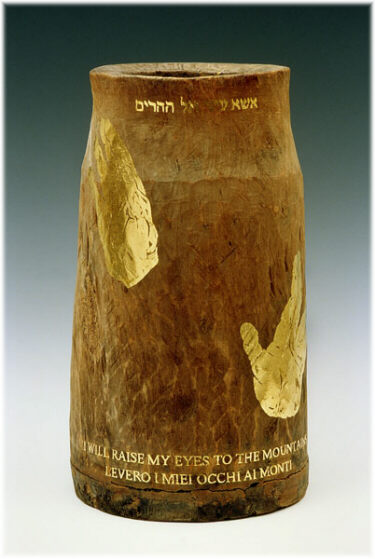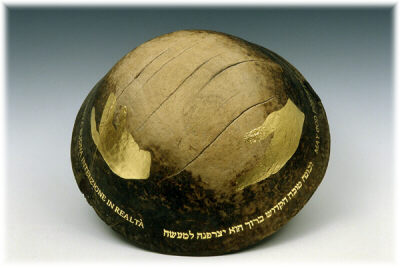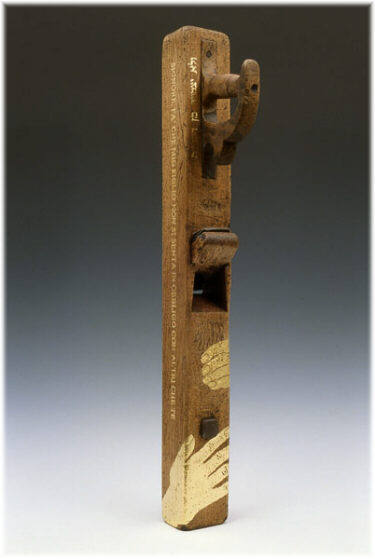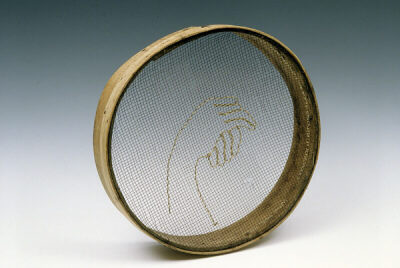“It’s beautiful. It’s brilliant. We’ll never show it.”
 Such was the response California artist Beth Grossman received when presenting her latest body of work to Jewish museums and galleries across the United States. With the exception of the Jewish Community Center of San Francisco, all of the institutions she contacted rejected her work, at times questioning its Jewishness. This was in stark contrast to the reception many of these institutions gave Grossman’s earlier work, Passages, an installation piece that opened at Ellis Island, traveled for eight years, and showed at prestigious venues such as the National Jewish Museum in Washington, the National Museum of American Jewish History in Philadelphia, and the San Francisco Jewish Museum. Like her earlier work, this latest project deals with issues of Jewish heritage and identity in the life of a Jewish woman. But whereas the Ellis Island project centered upon the artist’s great-grandmother, and her immigration from Russia to the United States, Grossman’s recent work, Our Mother Mary Found, tells the story of another, more famous, Jewish woman: Mary (Miriam), the mother of Jesus.
Such was the response California artist Beth Grossman received when presenting her latest body of work to Jewish museums and galleries across the United States. With the exception of the Jewish Community Center of San Francisco, all of the institutions she contacted rejected her work, at times questioning its Jewishness. This was in stark contrast to the reception many of these institutions gave Grossman’s earlier work, Passages, an installation piece that opened at Ellis Island, traveled for eight years, and showed at prestigious venues such as the National Jewish Museum in Washington, the National Museum of American Jewish History in Philadelphia, and the San Francisco Jewish Museum. Like her earlier work, this latest project deals with issues of Jewish heritage and identity in the life of a Jewish woman. But whereas the Ellis Island project centered upon the artist’s great-grandmother, and her immigration from Russia to the United States, Grossman’s recent work, Our Mother Mary Found, tells the story of another, more famous, Jewish woman: Mary (Miriam), the mother of Jesus.
The Virgin Mary is, of course, hardly neutral territory for any artist. Even apart from the obvious religious taboos and sentiments, the aesthetic constraints are daunting in light of an iconographic tradition, forged by church doctrine, that hasn’t changed much over the past 1000 years. A quick glance through the illustrations accompanying Jaroslav Pelikan’s, Mary through the Centuries, reveals just how conservative that tradition is. Even Chris Ofili’s controversial painting of the Virgin, adorned with elephant dung, retained the traditional, blue-cloaked figure — the same one, albeit white-skinned and blue-eyed, that appears in bathtub shrines across America.
Little trace of that graven image remains in Grossman’s work, which reclaims the iconic figure of the Virgin Mary as a Jewish mother, removing her from the gilded tabernacles and hagiographic narratives that usually confine and define her. Our Mother Mary Found is an installation deceptively simple in form and decoration. Ten found objects, rustic wooden tools and vessels, are transformed, by the appearance of gilded hands and illuminated Jewish prayers, from mundane artifacts into sacred objects. The hand-crafted tools correspond, either visually or conceptually, to ten events in Mary’s canonical life. The conception of Mary’s son is recalled by the uterus-shaped butter churn, whose ability to transform milk into butter also speaks to the transformation that occurs within the womb. An overturned bowl recalls Mary’s pregnant belly and serves as a symbol of abundance. An upright plane represents the cross upon which her son was executed. Mary’s own death is recalled by a sieve, symbolizing the thin mesh that separates life from death. These are the kind of tools the artist imagined Mary might have used, or her husband and son might have made. Most still bear the marks of their original fabrication and long use. Chisel marks and abrasions dent the hewn forms, prompting the viewer to imagine the many different pairs of hands through which these objects have passed: from the first pair that made them to the final pair that used them. Now a very different set of hands, rendered in gold leaf, embraces these tools and remakes them once again.
 The gilded hands belong to Mary, and their carefully choreographed gestures are taken directly from medieval, renaissance and baroque paintings depicting her joys and sorrows. Grossman recognizes that these gestures, the most expressive elements in traditional Marian imagery, functioned as a standardized code. Each of the episodes in Mary’s life are referred to by a specific gesture, a gesture that reveals the behavioral norms of the ideal mother: submission, devotion, humility, self-sacrifice and suffering. Alongside the hands, Grossman presents Mary’s devotional life in gilded texts taken from an eighteenth-century prayer book for Jewish women. Transcribed in three languages, Hebrew, English and Italian, these are the prayers the artist imagines Mary reciting at specific moments in her life and they present a linguistic representation of the changing geographical and historical context for those prayers.
The gilded hands belong to Mary, and their carefully choreographed gestures are taken directly from medieval, renaissance and baroque paintings depicting her joys and sorrows. Grossman recognizes that these gestures, the most expressive elements in traditional Marian imagery, functioned as a standardized code. Each of the episodes in Mary’s life are referred to by a specific gesture, a gesture that reveals the behavioral norms of the ideal mother: submission, devotion, humility, self-sacrifice and suffering. Alongside the hands, Grossman presents Mary’s devotional life in gilded texts taken from an eighteenth-century prayer book for Jewish women. Transcribed in three languages, Hebrew, English and Italian, these are the prayers the artist imagines Mary reciting at specific moments in her life and they present a linguistic representation of the changing geographical and historical context for those prayers.
Grossman has said she intended “to give a sense of Mary’s physical life,” showing “tools she, Joseph and Jesus could have used” but also “wanted to convey a sense of the sacred.” The project is informed by the aesthetics of enshrinement, and is, as the artist states, “sacred art.” The use of gold leaf recalls painted icons, with their gilded backgrounds, manuscript pages with their illuminated text, and reliquaries with their bejeweled surfaces. Yet its limited use, on the surface of aniconic objects, prohibits the gold from transforming the objects into idols. The gold leaf also serves as one of the few reminders of the artist’s own labor. An unforgiving material, gold leaf must be applied at just the right time, under just the right environmental circumstances. It took Grossman over a year to complete the gilding. She found that the work itself became contemplative and reverential, “With gold leaf, you have to slow down, it’s a very meditative process.”
Obviously, though, the Virgin Mary is challenging for more than merely aesthetic reasons. Why is a self-identified “Jewish artist” creating a work about a Christian icon? Is this Jewish art, or were the Jewish museums right to exclude it from consideration?
====
The contemplative construction and reverential tone of Our Mother Mary Found, make it far less provocative than contemporary art that seeks to transform the sacred into the sacrilegious or satirical, as in, for example, Steve Rosenthal’s condom-veiled Virgin, Extra Virgin. Grossman’s work isn’t sarcastic or coy, and those expecting some kind of “extreme make-over,” or at least something involving urine or pornography, may be a little disappointed. But the very fact that Grossman both acknowledges Mary’s sacred place and honors her Jewishness is, in many ways, more radical than crowning her with latex. Turn back to the illustrations in Pelikan’s survey and one finds nothing there that even hints at Mary’s life as a Jew — apart from, in a chapter on Mary as “Daughter of Zion,” an ambiguous painting by Marc Chagall entitled The Pregnant Woman, a painting that, Pelikan admits, may not depict Mary at all. 
Grossman’s work, in contrast, is unambiguous both in terms of its subject matter and its Jewishness. Ironically, it is the abandonment of Mary’s Jewishness by the Christian tradition that led Jewish galleries and museums to find Grossman’s work threatening: after two millennia of effacement it is hard to think of the Virgin Mary as Jewish. The “Jewishness” of Grossman’s project is in question not because of her work, but because of the vast body of work to which she is responding.
In response to these criticisms, Grossman has prefaced the work with a textual narrative describing the circumstances that led to its creation. The story is one she tells repeatedly, not only in her artist statement, but also in public lectures and private conversations. The story of the working Jewish mother, the artist, serves to validate her work and defend her choice of subject matter: the working Jewish mother, the Virgin Mary. As told in the narrative, the project began in Italy, in 2000, where Grossman lived for a year enveloped by a culture largely defined by Marian devotion — a devotion that was highly visible and intensely visual. There she was compelled to look at Christian art she had previously ignored and dismissed as irrelevant. The imagery she slept through in art history classes now surrounded her as she moved through the streets, museums and galleries of Milan. Her three year old son accompanied her on these art walks, his presence keeping her from lingering too long over the mangled bodies of saints dominating many images. Serene images of the Virgin and Christ Child provided a welcome respite from the carnage of severed heads and flayed skin. These paintings led Grossman to consider, and reconsider, the subject of Mary. As a new mother herself, Grossman felt a connection with these images of maternal devotion. At the same time she questioned the traditional telling of Mary’s story and wondered how history would have changed, had Mary been revered as a Jewish mother, if her Jewish identity had been celebrated, rather than suppressed or ignored. Our Mother Mary Found is thus a reclaiming, and a reconsideration of a lost Jewish icon.
There are other Jewish elements as well. First, and most apparently, Our Mother Mary Found uses Hebrew quotes from the Hebrew Bible. Second, and more subtly, it owes much to Jewish traditions of multiple narrative. “I never understood why everybody was so obsessed with one story and how all of western art could be about one story,” Grossman told me. “In Jewish culture, we don’t have the one story, we have so many stories and all these different ways of interpreting them.” Third, by abandoning the figural representations so necessary to Christian art (and so familiar in images of the Virgin), Grossman can be seen as heeding the Biblical proscription against graven images: the body is alluded to, but not rendered, in these aniconic forms, with the exception, of course, of the gilded hands (which themselves evoke the Jewish iconographic tradition of hamsas). Fourth, Grossman’s work is animated by aspects of Jewish feminism which promote the telling of women’s stories previously neglected by the dominant Jewish tradition, often accompanied by new rituals, new wording, and new ceremonial vessels. (One of the most popular of these rituals, the Miriam cup – named for Moses’ sister and recognizing her contribution to the deliverance from slavery – now stands beside the cup of Elijah on many Seder tables.) This notion of the material object, with its ability to restate and symbolize the life and actions of a significant Jewish woman, to reinscribe her into the Jewish tradition, echoes in Grossman’s work.
Our Mother Mary Found offers an interpretation of Mary’s life that differs from those presented by the painted panels and canvases that inspired the project. The mute, static figure dominating those 16th and 17th century paintings is replaced by reminders of an active, tangible woman. Grossman gives Mary a physical life, through the use of artifacts documenting a domestic world, a world of ordinary labor. Through the inclusion of prayer, she gives Mary a voice. In biblical text and painted image, Mary rarely speaks. Grossman inverts that tradition: Mary is no longer the passive recipient of God’s will, or of the viewer’s prayerful petition. Without veering into the other stereotype of the garrulous Jewish mother, this Jewish mother has a voice. She is not just the passive hearer of the annunciation, or object of the gallery visitor’s gaze.
Despite this inversion, and the presence of the specifically Jewish prayers, the work contains explicit reference to an entirely Christian visual tradition. Not only does Grossman take Mary’s gestures from this tradition, she also identifies her sources in each object’s title. The butter churn, for example, is entitled, ANNUNCIATION After Lorenzo Lotto 1480- 1556; the inverted bowl, MADONNA AND CHILD After Bernardo Zenale 1460- 1526; the plane, CRUCIFIXION After Boccaccio Boccaccino 1466-1525. With these titles, Grossman pays homage to an artistic tradition that she is, simultaneously, distancing herself from. The labels place her works in the context of western Christian art, a context that Grossman forces the viewer to acknowledge, if not accept.
 And it hasn’t been easily accepted, particularly by Jewish audiences. Grossman is frequently asked, “If this is a Jewish story, a Jewish project, by a Jewish artist, why are you using Christian titles, like the Annunciation, and the Assumption?” In response, Grossman says that the referential frame is essential, it links the work to the context within which she first encountered Mary, a context that prompted her act of reclamation. But she understands the confusion. “I have to say that had I not had the experience of living in Italy, of getting into the paintings, I would not have reacted the same way. I would have dismissed the work as some sort of ‘Jesus thing.'” Grossman views her work as a personal documentation of her own experience, an experience that occurred in a Christian culture and was prompted by Christian images. As a result, her work recognizes, and even honors, that Christian artistic tradition. But for many, including those who reject her work, the retention of this Christian link is problematic as it recalls a history of church art that frequently denigrates, rather than celebrates, Judaism. Many may find it ironic, and perhaps bitterly so, that the work recognizes a Christian visual tradition that, itself, erased any sense of the Jewish. Finally, the visual and textual elements that form the Christian frame of reference can become a barrier, preventing many from seeing the Judaic tradition that also informs the work. Although it is easy to identify the elements that are distinctly “not Jewish,” it’s harder (though ultimately more rewarding) to discern the Jewish ones.
And it hasn’t been easily accepted, particularly by Jewish audiences. Grossman is frequently asked, “If this is a Jewish story, a Jewish project, by a Jewish artist, why are you using Christian titles, like the Annunciation, and the Assumption?” In response, Grossman says that the referential frame is essential, it links the work to the context within which she first encountered Mary, a context that prompted her act of reclamation. But she understands the confusion. “I have to say that had I not had the experience of living in Italy, of getting into the paintings, I would not have reacted the same way. I would have dismissed the work as some sort of ‘Jesus thing.'” Grossman views her work as a personal documentation of her own experience, an experience that occurred in a Christian culture and was prompted by Christian images. As a result, her work recognizes, and even honors, that Christian artistic tradition. But for many, including those who reject her work, the retention of this Christian link is problematic as it recalls a history of church art that frequently denigrates, rather than celebrates, Judaism. Many may find it ironic, and perhaps bitterly so, that the work recognizes a Christian visual tradition that, itself, erased any sense of the Jewish. Finally, the visual and textual elements that form the Christian frame of reference can become a barrier, preventing many from seeing the Judaic tradition that also informs the work. Although it is easy to identify the elements that are distinctly “not Jewish,” it’s harder (though ultimately more rewarding) to discern the Jewish ones.
It is significant that it was the Mary’s painted hands that first drew Grossman into the imagery that inspired her work. She has always been captivated by hands, frequently remembering the hands, rather than the faces, of the people she meets. The image of the gesturing hand is found throughout Grossman’s work. It appears in the images honoring her grandmother’s actions and conversations. This use of the hand links Grossman’s work with the traditional Jewish art of remembrance. Evidence of this can be seen in almost any cemetery, where Jewish gravestones are marked by gesturing hands. Hands are raised in blessing, the mark of the kohein. Hands lift a pitcher of water. Hands drop money into a tzedakah box. Lives are summarized by gestures, gestures that memorialize a devout action. Grossman chose to remember Mary as a Jewish woman, through the gesture of her hands, through the trace of her actions. Our Mother Mary Found remembers a loss, the death of an identity, but also celebrates the beauty and brilliance of a Jewish mother, Miriam, daughter of Zion.








Hiya, I’m really glad I have found this information. Today bloggers publish just about gossip and internet stuff and this is really irritating. A good blog with interesting content, that’s what I need. Thanks for making this site, and I will be visiting again. Do you do newsletters? I Cant find it.